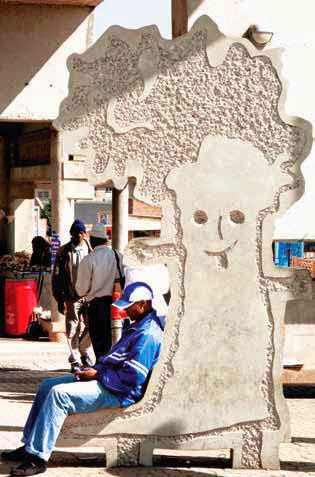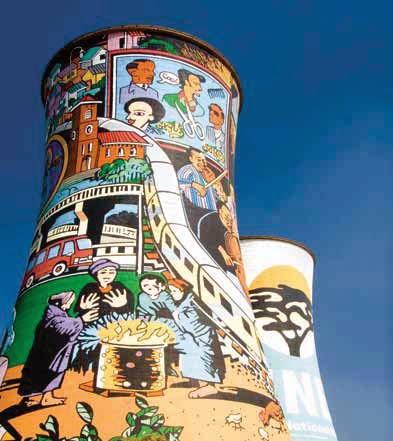The vast township of Soweto, once the centre of violence and turmoil in the struggle against apartheid, has become something of a scenic tourist attraction in the 20 odd years since the end of National Party rule.
GETTING ITS NAME from the apartheid designation of South Western Townships, Soweto was built as a shantytown on the edge of Johannesburg. It was essentially a dumping ground for black citizens, far from work and the white suburbs. Between 1955 and 1958 the government, vigorously implementing its apartheid policies, moved thousands of black South Africans from the city to Soweto.
As with all townships, it was ignored by the former regime. Its dusty roads were unpaved and tiny matchbox houses were built out of a mix of iron, wood and brick. Backyard shacks and informal settlements marked the place, which, at over 200 km², is the largest township in the country. By 2003, Greater Soweto consisted of 87 townships. Today it is almost unrecognizable. It has become an economic hub of activity with a fully fledged upper, middle and lower social class. Its roads are tarred and trees shade its many green spaces.
Rebuilding the Township
Since 1994, a huge amount of work has gone into developing Soweto and reintegrating it into the Great Johannesburg. More than 100,000 houses have been built or refurbished in the township over the past 20 years, according to the Presidency’s Twenty Year Review, and all outstanding water, electricity and sanitation connections to thousands of houses have been completed. Sowetan residential property is now booming, with the highest average prices in the affordable housing market segment countrywide.
Some 314 km of gravel roads have been tarred, and all other roads resurfaced, kerbed, pedestrianised, linked to new cycleway, provided with street lights, and integrated into a comprehensive storm water system. Soweto is also home to Africa’s biggest healthcare facility, Chris Hani Baragwanath Hospital.
Over the past 20 years retail space has grown from fewer than 60,000 m² to 220,000 m². Five new major shopping malls with major retail anchor tenants have been established, including the flagship Maponya Mall.
A new tourism spine has brought in over one million visitors keen to explore and understand Soweto’s role in the struggle against apartheid. The spine links the Vilakazi Street precinct, where tourists can see the house museums of Soweto’s two Nobel Peace Prize winners, Nelson Mandela and Emeritus Archbishop Tutu. Also included in the area are the Hector Pieterson Memorial and Museum, the 12 km June 16th Route, and the Regina Mundi Parish Church, before the route loops back to Kliptown, where the Freedom Charter was signed.
Other tourist attractions include the Oppenheimer Tower, Credo Mutwa Cultural Village, and Orlando Towers, former cooling towers which are colourfully painted and now offer spectacular views of the city, as well as heart-stopping bungee jumps. The township also hosts the Soweto Open tennis tournament, the Soweto Marathon, and the Soweto Wine Festival.
The Home of South African Soccer
Soweto has produced the highest number of professional soccer teams in the country. Orlando Pirates, Kaizer Chiefs and Moroka Swallows were all born there, and remain among the leading teams in the Premier Soccer League.
 |
| The Soweto Derby: Kaizer Chiefs VS Orlando Pirate |
Sport is big in the area. FNB Stadium, the country’s largest stadium, is in Soweto. Known as Soccer City during the Fifa Soccer World Cup in 2010, for which it was purpose built, it is the centre of soccer in South Africa. It is the home ground of the national soccer team, Bafana Bafana, as well as Kaizer Chiefs, and the preferred venue for major concerts.
Converting Hostels Into Homes
Apartheid’s migrant labour system relied on men transported far from their homes into the city, where they would live and work. These labourers were often housed in single-sex hostels, but today, the Johannesburg Housing Company is busy converting these structures into comfortable family homes.
Once such development is Orlando Ekhaya, an affordable rental housing project. Here the City of Johannesburg has invested some R130 million in good quality, high-density family flats in the Soweto suburb of Orlando. Hostels elsewhere in Soweto are getting the same treatment.
Half a Million Trees
Johannesburg is known as the world’s largest manmade urban forest, with some of its trees dating back to the early 1900s. But while the city itself was green, for decades Soweto was drab and dusty, with only a few trees planted in the 1950s. The Greening of Soweto Project, launched in 2006 with the planting of 6,000 trees – and an ultimate aim of half a million – is perhaps the city’s biggest green revolution.
Transport Upgrades
Given the almost total lack of investment in public transport by the previous government, minibus taxis and rail were for decades the main means of getting around Soweto and into Johannesburg. The township’s transport hub is the Bara Bus and Taxi Rank, opposite the Chris Hani Baragwanath Hospital. The rank, the biggest and busiest bus and taxi rank in Soweto, was given a massive facelift in 2003 thanks to a R60 million government investment over a three year period. According to the City of Joburg Property Company, R100 million was spent on the Bara Central Redevelopment, which aimed to transform the public environment, and upgrade the area into a vibrant high-density, mixed-use destination with an underground parkade, a new public square with artwork, and an upgrade of the streets. Twenty years of freedom have seen heavy investment in Soweto’s public transport. The City of Johannesburg’s Rea Vaya bus rapid transit system was first rolled out in the township to provide affordable transport.
Shopping Malls, Businesses and a Theatre
 A number of neighbourhood shopping centres were developed in the 1980s around Soweto, but it was only in 1994 that Soweto’s first major shopping complex was built, in Dobsonville. In 2005, the Protea Gardens Mall opened, followed by the Bara Mall in Diepkloof, adjacent to the hospital and taxi rank, and in 2006 the Jabulani Mall.
A number of neighbourhood shopping centres were developed in the 1980s around Soweto, but it was only in 1994 that Soweto’s first major shopping complex was built, in Dobsonville. In 2005, the Protea Gardens Mall opened, followed by the Bara Mall in Diepkloof, adjacent to the hospital and taxi rank, and in 2006 the Jabulani Mall. The following year, Soweto’s homegrown millionaire, Richard Maponya, opened the township’s first mega mall, the 65,000 m², R650 million Maponya Mall on Chris Hani Road.In 2012, the City of Johannesburg opened the stateof-the-art Soweto Theatre as part of a multimillion-rand investment in Jabulani. It includes a R320 million shopping mall, the 300-bed Jabulani Provincial Hospital, and a residential area with three- to five-storey walk-up blocks of flats.
Business facilities in Soweto are also being considered, and in her State of the Province address in 2013, Gauteng Premier Nomvula Mokonyane said the provincial government had partnered with Century Property Development Company to establish a R1.6-billion industrial park in Diepsloot. The once dusty and desperate streets of Soweto are being turned into a tidy city, complete with all the facilities and amenities needed for modern life.
SEE FLIGHT SCHEDULE FOR MORE INFORMATION CLICK HERE: SA EXPRESS FLIGHTS




0 comments :
Post a Comment